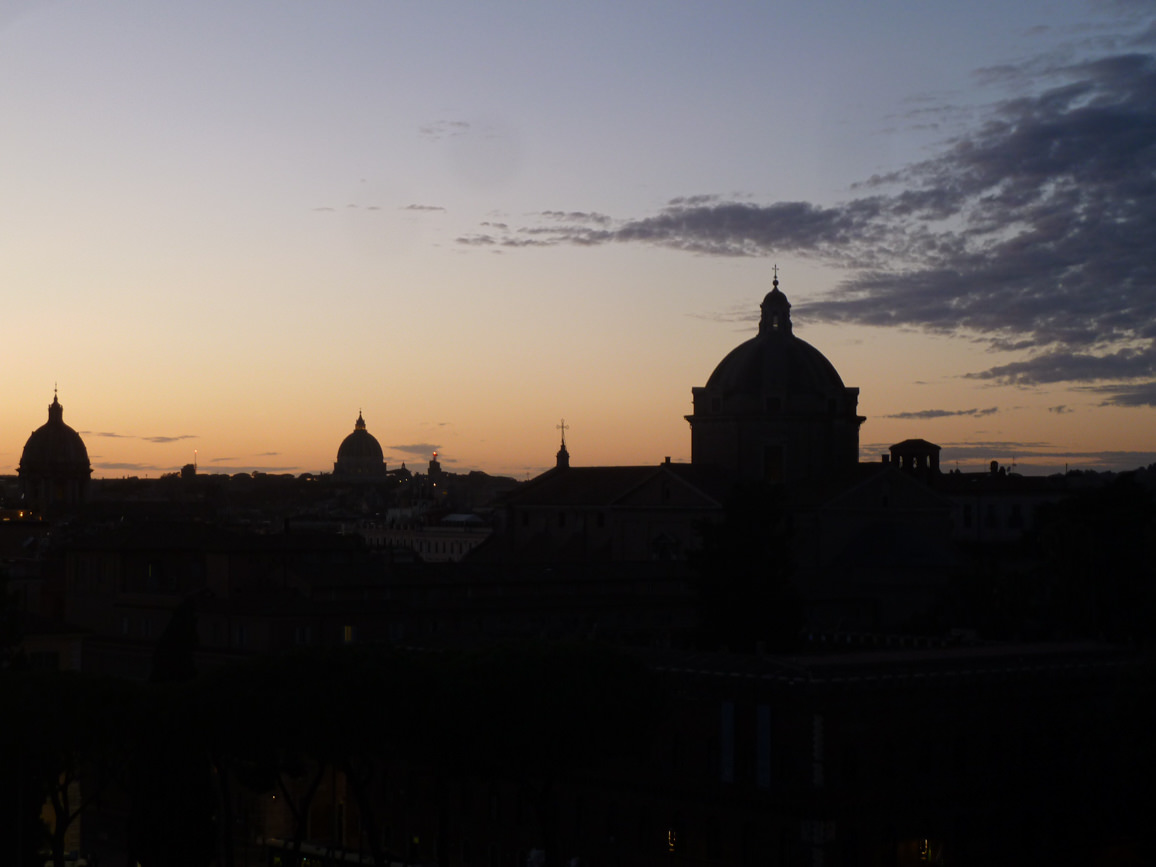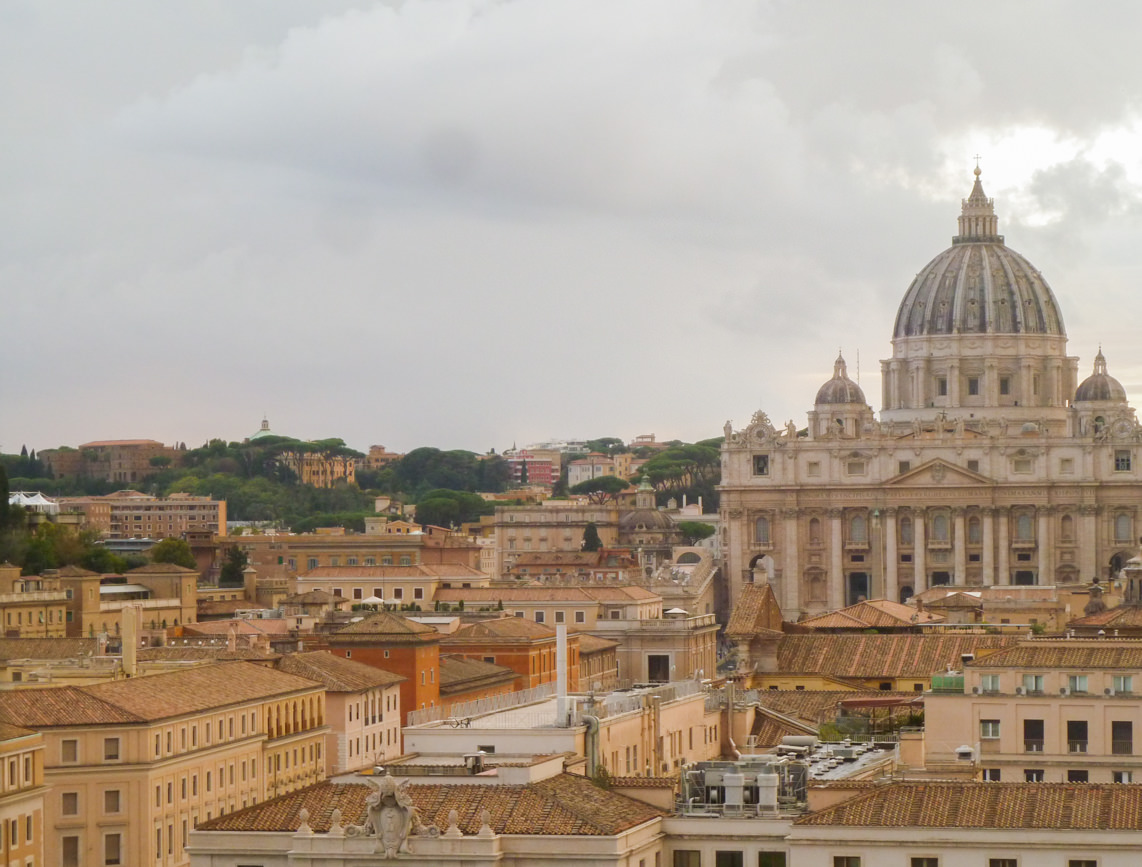
Rome (also known as Roma in Italian or the Eternal City) is the imposing capital of Italy. You could literally spend a lifetime exploring its fantastic ruins, monumental fountains, and breathtaking churches as there are endless attractions, but here’s my shortlist of the 12 things you should see and do in Rome. Ready to get started?
In my opinion, the ideal length when planning your trip to Rome is at least three to four days.
If you would like to see and do the twelve things listed below, you may do so in a shorter period of time (i.e. a weekend), but take into account that you would then need to do most of the sightseeing from the outside, without entering many of these attractions. Even if doable, it would be a pity: I consider that many of these monuments are worth visiting at least once in a lifetime!
In any case, here’s a suggested itinerary plan for three days in Rome.
- Day 1: spend the whole morning exploring the Colosseum, Via dei Fori Imperiali, the Roman Forum and the Palatine Hill; in the afternoon, walk around the various charming squares (Piazza del Popolo, Piazza di Spagna, Piazza Navona) and admire the colossal Fontana di Trevi and the Pantheon.
- Day 2: devote most of your day to visit the imposing Vatican City (note that the last Sunday of every month is free!); later on, you can head to Castel Sant’ Angelo for unforgettable sunset views.
- Day 3: during the morning of your last day, take it easy at Villa Borghese and the Pincio terrace; in the afternoon, you can visit Bocca della Verità and admire a panoramic view of Rome from Giardino degli Aranci. Finish off by trying the delicious Roman cuisine (you will obviously do so every day).
Should you have more time, you can always take it easy and sightsee without being in a rush. On that note, I’ve included a section on ‘More things to see and do in Rome and beyond‘ towards the end of this post. You can also check my ‘Rome travel guide (+map)‘.
For each of the 12 essential experiences that I would recommend seeing or doing in Rome, I’ve also indicated the nearest metro stop. Similarly, the Roman landmarks are mentioned in the suggested order of the 3-day itinerary.
At the end of this post, you will find a map with all the locations mentioned here.
My 12 essentials to see and do in Rome
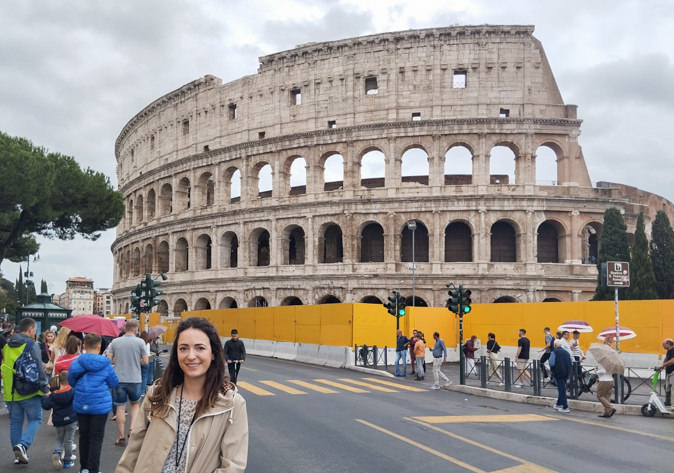
Colosseo, Via dei Fori Imperiali, Foro Romano and Palatino
Our Roman tour starts in one of the most famous monuments of the city: the Colosseum. Considered one of the seven New Wonders of the World, it dates back two thousand years!
Built between 72 and 80 AD under the Flavian emperors and therefore originally known as the Flavian amphitheater, this colossal building is a tribute to the passion for bloody spectacle under the Roman empire. When Emperor Titus inaugurated it in 80 AD, he declared 100 days of games, some of them including the sacrifice of 5,000 beasts. Imagine gladiator fights and naval battles taking place in this breathtaking location.
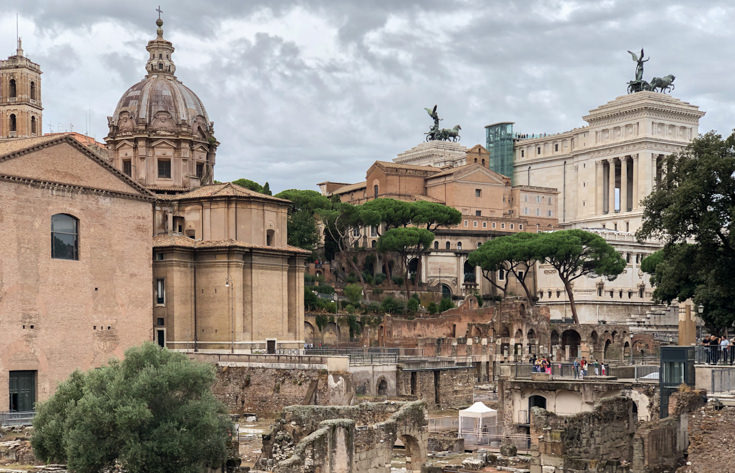
The Colosseum lies at the end of an imposing avenue known as Via dei Fori Imperiali. On both sides of this historic street from the fascist era of Mussolini, you will find some of the most grandiose and notable ancient remains of the city of Rome such as the Trajan’s markets (Mercati di Traiano), the homonymous Forum and column, the Arch of Constantine, the Mamertine Prison, as well as the Forums of Nerva, Julius Caesar or Augustus.
The vast archaeological area of the Roman Forum (Foro Romano) is located to the right of Via dei Fori Imperiali when facing the Colosseum. Originally covered by a swamp, this was once the bustling heart of the political, judicial and commercial power in ancient Rome. Nowadays it is an evocative void dotted with grandiose archways, solitary columns and sculpted rubble. Some of the main attractions within the Roman Forum include the Arches of Septimius Severus and Titus, the Temple of Vesta and the House of the Vestal Virgins, the Curia, the Via Sacra, the Basilica of Maxentius and Constantine and various Temples (Castor and Pollux, Vespasian and Titus, Saturn, Antoninus and Faustina).
For a free and panoramic view of the Roman Forum, you may head to the balcony behind the Campidoglio.
The Palatine Hill (Palatino) is adjacent to the Roman Forum. This area houses the remains of Iron Age settlements such as Romulus’ hut, the founder of Rome, and were home to important civic cults such as Magna Mater identified as Cybele. Over the centuries, the hill became the residential district where Roman aristocracy lived and where imperial palaces were built (Domus Flavia, Domus Augustana, Domus Septimius Severus, the House of Livia or the Neronian Cryptoporticus). During the Renaissance era, aristocratic families continued to build villas on the hill and also planted vineyards and gardens. Some examples of the latter include the Farnese Gardens (Horti Farnesiani) or the Loggia Stati-Mattei. Many of the artifacts that were found in the excavations of the Palatine Hill area are currently displayed in the Palatine Museum.
Nearest metro stop to visit the Colosseum, Via dei Fori Imperiali and the Roman Forum: Colosseo
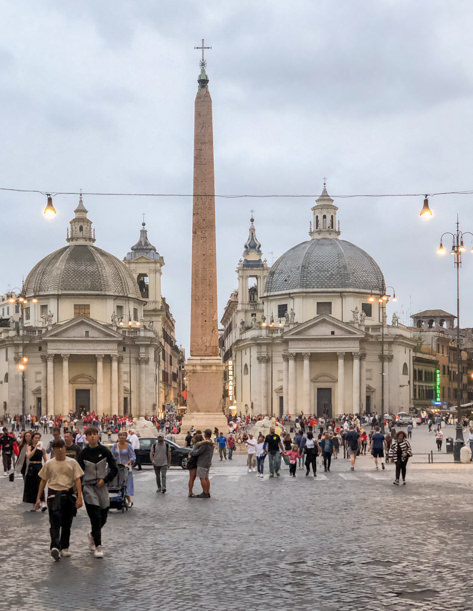
Piazza del Popolo
Piazza del Popolo (literally meaning the people’s square) is beautifully symmetrical.
Between 1811 and 1823, the architect Giuseppe Valadier turned this place of festivals and public executions into an elegant square by adding four fountains with lions to the base of one of the oldest obelisks in Rome.
Next to the Porta del Popolo (formerly known as Porta Flaminia) lies the imposing church of Santa Maria del Popolo. Built on the tombs of Roman emperors, it offers one of the richest samples of Renaissance and Baroque art in Rome with works by Pinturicchio, Raphael, Caravaggio and Bernini.
You will find the twin churches of Santa Maria dei Miracoli and Santa Maria in Montesanto, built next to each other, in the other end of the square.
Finally, three major streets (known as Tridente by the locals) depart from Piazza del Popolo: via del Corso, via Ripetta and via del Babuino.
If you’re looking for a panoramic view of Piazza del Popolo and Rome in general, you can head to the nearby Terrazza del Pincio in Villa Borghese. Read my post about the best panoramic views of Rome for further information.
Nearest metro stop to visit Piazza del Popolo: Flaminio
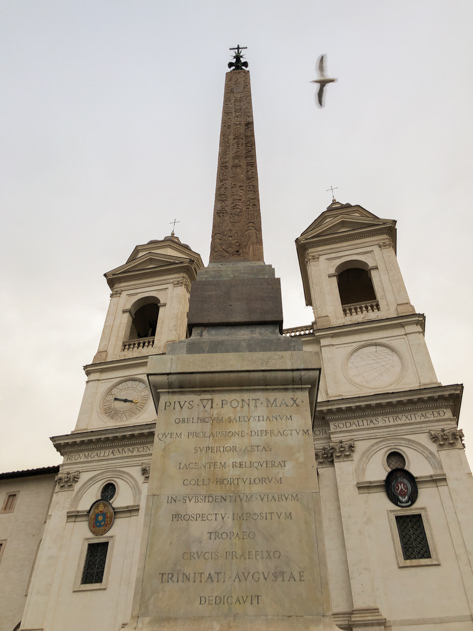
Piazza di Spagna
This is one of the most famous squares in Rome, and it owes its name to the nearby Spanish Embassy. It features an hourglass shape.
Three elements stand out in Piazza di Spagna:
- The staircase (Scalinata della Trinità dei Monti): Francesco de Sanctis designed this majestic staircase between 1723 and 1726 for French King Louis XV, making it one of the most appreciated Rococo monuments in Rome and a popular spot for locals and tourists alike. It reaches its splendor in the spring months, when it is covered with azaleas.
- Chiesa della Trinità dei Monti: this church overlooking the square crowns the staircase of Piazza di Spagna. Built by the French, it was part of a convent founded by King Louis XII in 1503. The Baroque interior houses frescoes by Daniele da Volterra, including a portrait of his master Michelangelo.
- La Barcaccia: possibly Bernini’s father, Pietro, helped his son build this 1612 fountain. Depicting a sinking boat, the design ingeniously solved the problem of low water pressure by creating a boat through which water trickles instead of fountains or waterfalls.
After visiting Piazza di Spagna, you may wish to go shopping (or at least window-shopping) along Via Condotti. This is where the Italian luxury brands such as Armani, Bulgari, Gucci or Prada display their expensive products in fabulous stores.
Nearest metro stop to visit Piazza di Spagna: Spagna
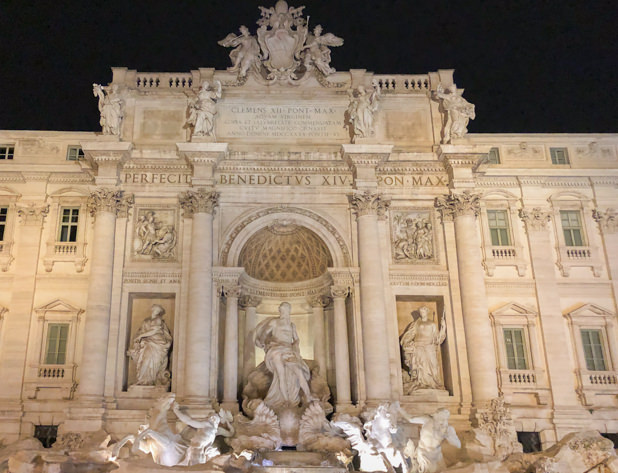
Fontana di Trevi
Thanks to the world of cinema, this fountain is one of the best-known images of Rome and probably the most popular attraction in town. Always crowded with tourists at any time of the day or night, the absolute beauty and power of this creation is truly captivating.
Built in 1732 by Nicola Salvi and attached to the back of a palace, this majestic fountain marks the end of the Acqua Vergine aqueduct built by Agrippa in 19 BC from a source miraculously discovered by a virgin.
When paying a visit to the Fontana di Trevi, don’t forget to throw a coin with your back to the pool. Legend has it that if you do so, you will return to Rome! But rest assured, the coins are collected every morning. 🙂
Nearest metro stop to visit the Fontana di Trevi: Barberini
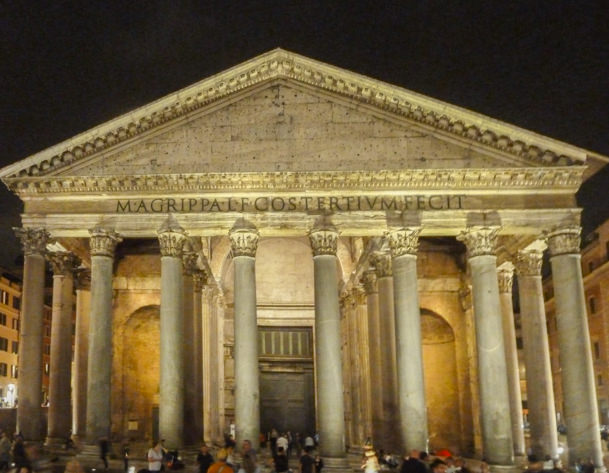
Pantheon
Located in Piazza della Rotonda, the Pantheon is the best-preserved ancient temple. Considered a marvel of architectural engineering, it features a gigantic oculus eternally open to the sky.
First built by Agrippa in 27 BC, the Emperor Hadrian later perfected it by designing a beautiful structure between 118 and 125 AD. Although the Pantheon was looted over time, its spacious interior and its perfect proportions have been maintained. The dome of the Pantheon, measuring 43 meters in diameter, is the largest in Europe and gives it its distinctive ethereal air. Probably the most famous feature of the Pantheon is the oculus, a bold 8.3 meter diameter hole in the center of the dome that provides both light and structural support. If you get a chance, head to the Pantheon on a rainy or snowy day to admire the water falling through the oculus, splashing the marble floor and getting lost in a drain. Some distinguished personalities are buried in the Pantheon, including two Italian kings (Vittorio Emanuele II and Umberto I), as well as artists of the stature of Raphael and Baldassare Peruzzi.
In front of the Pantheon, you will also find a staircase with a fountain surmounted by an Egyptian obelisk.
Nearest metro stop to visit the Pantheon: Barberini
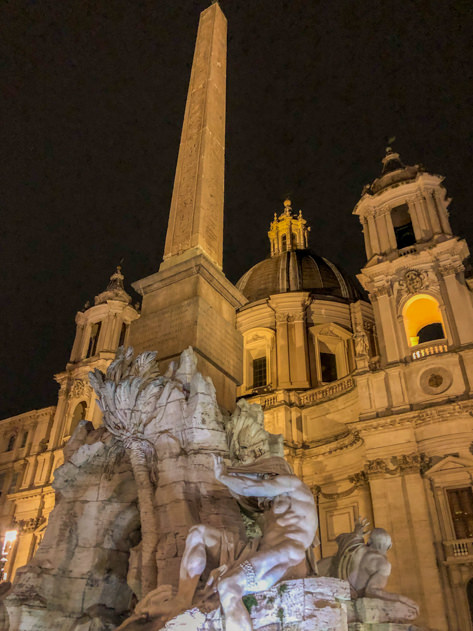
Piazza Navona
The elongated oval of the most charming of Rome’s squares hints that it was built on the ancient stadium of Domitian. This pedestrian paradise is full of cafes, street performers, tourists and splashing fountains.
Piazza Navona is surrounded by magnificent Baroque buildings such as Palazzo Pamphilj (now housing the Brazilian Embassy) or the church dedicated to Sant’ Agnese.
Even more impressive are the three fountains located in Piazza Navona:
- Fontana del Nettuno: designed by Giacomo della Porta in 1576, this marble sculpture represents the god Neptune fighting with an octopus.
- Fontana dei Quattro Fiumi: lying at the very center of the square, this fountain designed by Bernini in 1651 depicts four rivers representing the continents (the Asian Ganges, the European Danube, the American River Plate and the African Nile). An obelisk completes this sculptural masterpiece.
- Fontana del Moro: this ornate fountain dating from the 16th century represents a Moor, or African, standing on a seashell with a waterfall, fighting with a dolphin, surrounded by four mermen, situated on a pink marble base.
Nearest metro stop to visit Piazza Navona: Barberini or Lepanto
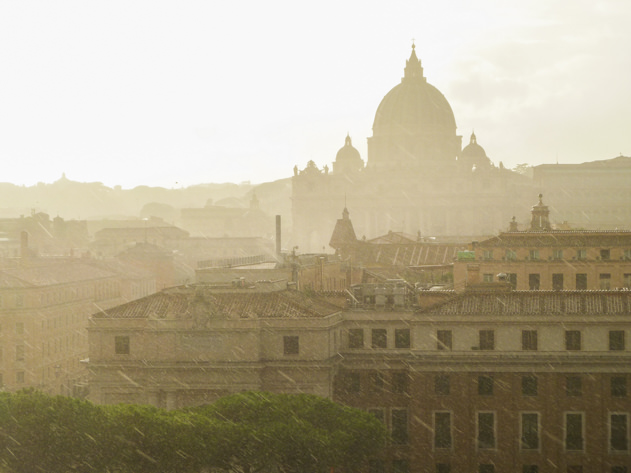
Vatican City (Stato della Città del Vaticano)
This tiny city state is home to the Pope’s home, the largest church, and the most impressive work of art ever created: the ceiling of Michelangelo’s Sistine Chapel. Truly one of the 12 things you must see when in Rome!
With an area of only 50 hectares, the Vatican is the smallest nation in the world. However, its monumental complex is unparalleled. Within its walls lie St. Peter’s Basilica, the impressive Sistine Chapel and some 10 museums containing Egyptian, Etruscan, Greek and Roman collections, Paleo-Christian, Renaissance and modern art, and a world-renowned ethnographic collection.
The imposing St Peter’s Square at the end of Via della Conciliazione marks the starting point to the grandiosity of the Vatican. Bernini’s extraordinary semi-elliptical colonnades transformed the approach to the basilica into a pair of welcoming arms that envelop the believer. The obelisk comes from the Egyptian city of Alexandria.
The Papal Basilica of Saint Peter is one of the landmarks in Vatican City, not only because of its massive size but also given its religious and artistic significance. These are the essentials you should cover during your visit to St Peter’s Basilica: the statues of Pietà by Michelangelo and St Peter by Arnolfo di Cambio, the Baroque baldachin by Bernini, the Treasury, St Peter’s tomb and the dome.
Make sure to climb to the dome of St Peter’s Basilica for breathtaking panoramic views of Vatican City and Rome.
The Vatican Museums (Musei Vaticani) are another essential stop when visiting Vatican City. This gigantic complex houses numerous museums and some of the most remarkable art pieces. Listed below are the top 10 highlights that I would recommend checking out during your visit to the Vatican collections:
- The Sistine Chapel: this ceiling by Michelangelo is one of the most spectacular works of art in the world.
- Raphael’s Rooms: decorated by Raphael for Pope Julius II between 1508 and 1524, one of the frescoes that stands out is his masterpiece ‘The School of Athens’ depicting the marriage of art, philosophy, and science.
- Apollo Belvedere: housed in the Octagonal Court, this Roman copy of a Greek statue from the 4th century BC is considered a model of physical beauty.
- The Transfiguration by Raphael: this painting was left unfinished when Raphael died in 1520 and is considered the culmination of his career. One of his disciples completed the work.
- The Chapel of Nicholas V: the Niccoline Chapel is one of the Vatican’s hidden gems. Attributed to Fra Angelico, the frescoes colorfully depict martyrs Saints Steven and Laurence.
- The Laocoon or Laocoön: this famous marble sculpture was found in 1506 and is now located in the Octagonal Court of the Vatican Museums. It represents the battle between a Trojan priest and his sons against divinely sent sea-snakes during the Greek-Trojan war.
- Caravaggio’s Deposition of Christ: considered one of his greatest masterpieces, this painting from 1604 of striking realism accentuates its diagonal composition thanks to the chiaroscuro technique.
- The Borgia Apartment: between 1492 and 1495, Pinturicchio was entrusted by Pope Alexander VI to decorate his lavish rooms with elaborate frescoes.
- The Belvedere Torso: the expertly modeled protuberant muscles of this torso of the god Hercules, from the 1st century BC, served as a model for the first sketches of Michelangelo and other Renaissance masters.
- Leonardo da Vinci’s St Jerome: sketched and unfinished, this painting from 1482 is still a masterpiece of anatomy.
TIP: The Vatican Museums are free the last Sunday of every month, with shorter opening hours and provided that it doesn’t coincide with some specific dates. If your schedule allows, try to plan your visit around a Sunday!
Nearest metro stop to visit Vatican City: Ottaviano
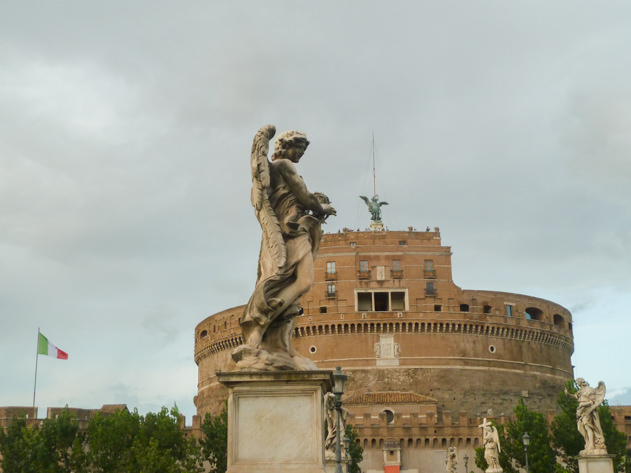
Castel Sant’ Angelo
Over the centuries, this fortress by the Tiber river and close to the Vatican has been used as a mausoleum, a prison and military quarters. Nowadays, Castel Sant’Angelo houses a Museum.
The Roman emperor Hadrian designed his enormous circular tomb between 123 and 139 AD. Later on, Aurelian fortified it as part of the city walls. The fortress became a papal castle for a thousand years, actually connected to the nearby Vatican with a viaduct to allow the Popes to take refuge in it in times of crisis. Castel Sant’ Angelo houses Renaissance papal apartments with frescoes and a small collection of weapons and armors spanning from the Etruscan period to the 20th century.
My personal favorites when visiting this Roman landmark include the magnificent vaults along the helicoidal ramps as well as the memorable 360 degree views of the city of Rome and Vatican City from the upper terraces. If you can time your visit around sunset, even better!
Hadrian also built a bridge (Ponte Sant’ Angelo) around 133-134 AD to access his mausoleum. Today only three of its original central arches are preserved. In 1534, Pope Clement VII commissioned the installation of the statues of Saint Peter by Lorenzetto and Saint Paul by Paolo Taccone. In 1688, Pope Clement IX hired Bernini to design sculptures of ten angels holding symbols of the Passion.
Nearest metro stop to visit Castel Sant’ Angelo: Ottaviano or Lepanto
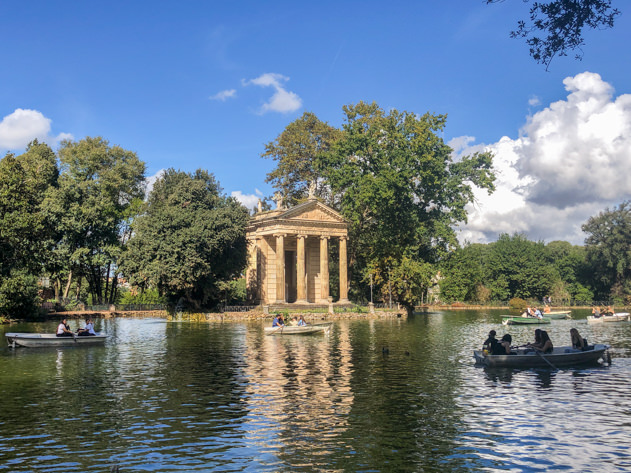
Villa Borghese and the Pincio terrace
Spanning over 688 hectares, Villa Borghese is the largest park in Rome. Back in 1608, Cardinal Scipione Borghese converted these family grounds into a private park, which was then open to the public in 1901. Currently, these vast public gardens house sculptures, fountains, groves, paths, pavilions and even a water clock, making it the perfect location for running, riding a bike, a relaxed walk, a picnic or paddling on the lake. During my most recent visit to Rome, I rented an electric bike with Uber. Although I found it expensive – I paid around 25 EUR for less than 2 hours – the experience was memorable!
Given its size, I highly recommend biking instead of walking in order to cover most of Villa Borghese in a shorter period of time.
Some of the most popular spots in Villa Borghese include:
- Renowned museums: the Galleria Borghese featuring Renaissance and Baroque art; Museo Nazionale etrusco di Villa Giulia housing ancient Etruscan artifacts; and the Galleria Nazionale d’Arte Moderna displaying contemporary art. Other attractions located in Villa Borghese are the Zoo (Bioparco) or the House of Film (Casa del Cinema).
- Lake by the Temple of Aesculapius: paddle a boat in an idyllic environment encompassing a classic temple.
- Pincio terrace: famous for being an incredible viewpoint of Piazza del Popolo and beyond, the Pincio is a hill in Rome. The area is surrounded by statues of Italian notables and by an obelisk commissioned by emperor Hadrian to honor his lover Antinous.
Nearest metro stops to visit Villa Borghese and the Pincio terrace: Flaminio or Spagna
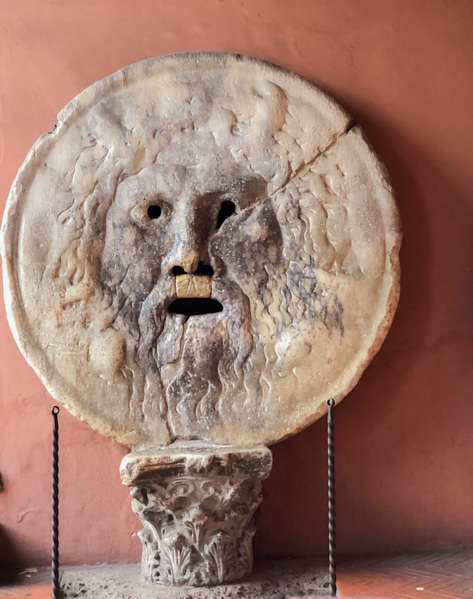
Bocca della Verità
Santa Maria in Cosmedin became a church in the 6th century, and a settlement for the Greek community in exile two hundred years later. However very little remains of its original ornamentation since the majority is from the 12th and 13th centuries.
In any case, the most popular element is Bocca della Verità (the mouth of the truth), an ancient cistern cover. According to legend, the mouth traps the hands of liars. This monument became famous thanks to the movie ‘Roman Holiday’ featuring Audrey Hepburn and Gregory Peck.
A few steps away is the Boario Forum. The name refers to the ancient cattle market that was located in this place. Today, the area is a small archaeological park with two well-preserved temples from the 2nd century BC and an arch dedicated to Janus from a later period. The rectangular temple honors Portunus, God of rivers and ports, while the circular one is the temple of Hercules. The area suffers from intense traffic but it is worth stopping by if you’re visiting Bocca della Verità.
From there, you may wish to cross to the nearby Isola Tiberina – a tiny island housing a hospital, various churches and restaurants – in order to explore the lively Trastevere district.
Nearest metro stop to visit Bocca della Verità: Circo Massimo
Head to a spot with panoramic views of Rome
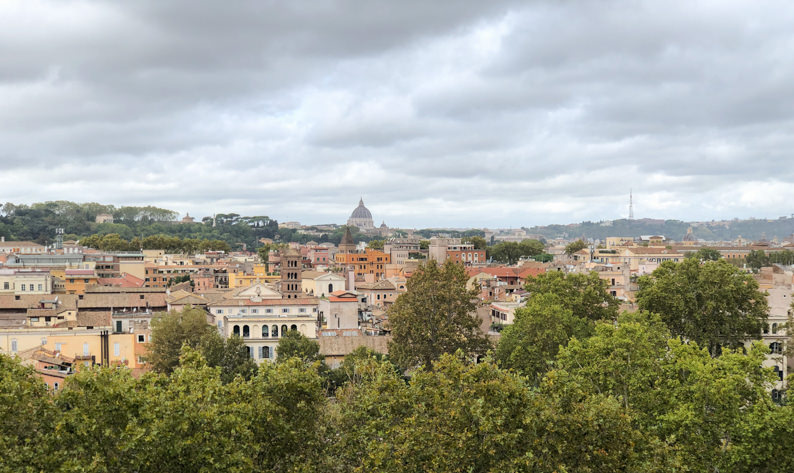
There are plenty of locations featuring breathtaking viewpoints of the Italian capital. For further information, you can read my post about the best panoramic views of Rome.
One of my all-time favorites is Giardino degli Aranci (the Orange Garden). Located on top of a hill near the Circo Massimo, you will first pass by the Rose Garden, a place radiating beauty specially during the spring and summer months. Continue along the old wall and enter the Orange Garden to enjoy the view of the river, the Trastevere neighborhood and St. Peter’s Basilica, or simply rest under the pine trees.
Right next door lies the church of Santa Sabina all’ Aventino.
Another popular stop is the nearby 18th century square (Piazza dei Cavalieri di Malta) by Giambattista Piranesi to look through the famous bronze keyhole framing the dome of Saint Peter. Beware of the long lines here though!
Nearest metro stop to visit Giardino degli Aranci: Circo Massimo
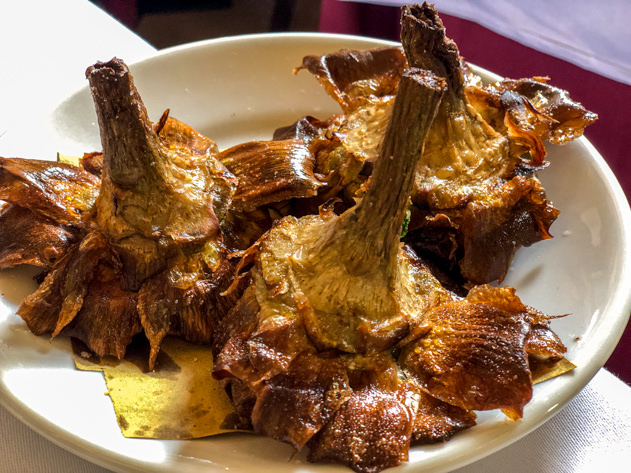
Try the local cuisine
Last on my list of 12 things to see and do in Rome is obviously FOOD. Rome is a paradise for food lovers, and offers endless cafeterias, ice cream parlors and restaurants to choose from.
Typical Roman dishes
Here’s a list of the most classical dishes in Roman cuisine that you may encounter during your visit to the Italian capital:
- Saltimbocca: beef escalope with sage and ham sautéed in white wine
- Bucatini all’ amatriciana: pasta with a tomato sauce and bacon seasoned with pepperoni and generously sprinkled with grated pecorino cheese.
- Carciofi alla romana or alla giudia: while the first type of artichokes (alla romana) are seasoned with garlic and mint braised in a mixture of olive oil and water, the second type (alla giudia) are crushed and then fried.
- Abbacchio scottaditto: roast lamb
- Spaghetti alla carbonara: pasta served with egg yolk, grated parmesan cheese, black pepper and bacon.
- Pajata: pasta served with a tomato sauce and calf intestines cooked in breast milk.
- Coda alla vaccinara: braised oxtail with celery and tomato broth.
- Gnocchi alla romana: potato and butter balls that can be served with a variety of sauces.
- Cacio e pepe: spaghetti with ground black pepper and grated pecorino cheese.
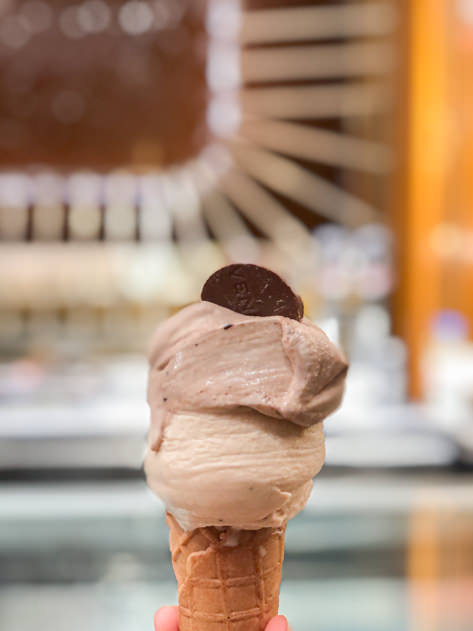
Where I ate during my visit to Rome
Below is a list of the places I tried during my last visit to the Italian capital, sorted by cafeterias, ice cream parlors and restaurants. Enjoy la dolce vita! 🙂
Cafeterias
- Allegrío: we had a delicious cappuccino and cornetto (croissant) in this fancy cafeteria / lounge bar / restaurant located in Via Veneto. Although it was on the expensive side, their coffee was out of this world and the interior design was worth checking out too.
Ice cream parlors
- Gelateria della Palma: this used to be my favorite ice cream parlor during my Erasmus exchange program in Rome back in 2007-2008. It is ideally located close to the famous Pantheon and features 150 flavors. This time around I tried frutti di bosco (wild fruits) and cioccolato all’arancia (chocolate with orange).
- Venchi: this Italian company renowned for its chocolate originated in the northern region of Piedmont. They have various stores around Rome. We stopped at their fancy branch in Via del Corso, where I ordered an ice cream with mango and Piedmont hazelnuts. Yum!
Restaurants
- Osteria delle Coppelle: we ordered insalata tiepida and a pizza di strecchino, speck, rucola e brulé di vino rosso in this cute restaurant with outdoor seating located in a charming square steps away from the Pantheon.
- Trattoria Da Teo: popular restaurant in Trastevere among locals and tourists alike. We enjoyed eating their delicious artichokes (carciofi alla giudia) and the ravioli ricotta e spinaci. The tiramisù for dessert was really good too.
- Momart Café: we came here for the ‘aperitivo‘, an Italian tradition that usually takes place around dinner time. You typically pay for the drink only (in this case it was 14 EUR) and the food and desserts are served in a buffet-style ‘all you can eat’. The place was packed with people from all ages and we had to wait a while to get in, but it was worth it. Their pizzas cooked in a wood-fired oven were hands down the best ones I tried during my Roman trip. The only downside is that it is a bit far away from the city center.
- Checchino dal 1887: considered one of the best restaurants in the city of Rome, this is the birthplace of ‘coda alla vaccinara‘ (braised oxtail with celery and tomato broth). Unsurprisingly, it is located in the Testaccio district, right next to the slaughterhouse (Mattatoio). We ordered a platter of four Italian cheeses as a starter, followed by coda alla vaccinara and trofie al pesto di rucola e mandorle con pecorino. We had panna cotta con salsa al caramello for dessert.
- Antica Osteria di Pietra: on our last day in Rome, we ordered a pizza capricciosa from here and decided to eat it while admiring the Fontani di Trevi and people-watching.
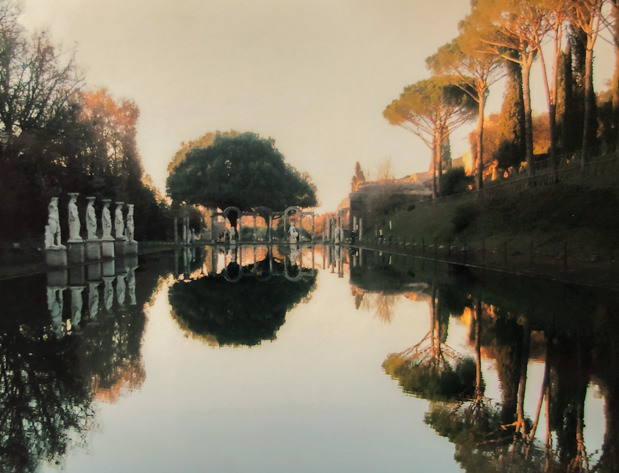
More things to see and do in Rome and beyond
In case you have more than three days to visit Rome, you may devote a longer time to visiting some of the landmarks mentioned above. Alternatively, you can also explore other attractions beyond the old Roman city walls (Rome extramuros) or even further away in the Lazio region.
Below is a list with some suggestions for additional things to see and do in Rome and beyond:
Rome extramuros
Although the best of Rome lies within its walls, venturing outside the 3rd century Aurelian Wall is worth it. Detailed below are some must-sees for anyone who wants to leave the Roman city center:
- Catacombs: outside the Roman city walls you will find a number of ‘catacombs’, which were former underground burial grounds. The most famous ones include the Catacombs of Domitilla (this is the biggest network), Saint Sebastian and Saint Callixtus (the first official Catholic cemetery of Rome).
- Churches beyond the Roman walls: San Paolo fuori le Mura is the second largest church in Rome and was built by Constantine in the 4th century where Saint Paul was buried. On a similar note, the churches of Sant’Agnese fuori le Mura and Santa Costanza are located in the same pre-Christian complex and feature sublime mosaics from the 4th century.
- EUR: this vast area was built by Mussolini on the occasion of the Universal Exposition of Rome, which never actually took place because of World War II. Showcasing an ideal fascist metropolis, the main highlights include the Palazzo della Civiltà del Lavoro and the Museo della Civiltà Romana.
- Ostia Antica: this was the main port during Roman times and a bustling commercial center. The extraordinary ruins of Ostia Antica provide an insight into life in ancient times, the main attractions being the Decumanus Maximus (the main avenue), the Theater, the Forum, the Capitol, two sets of baths (Terme dei Sette Sapienti and Terme di Nettuno) and even a Thermopolium (the equivalent of a bar with a marble counter and paintings advertising food and drinks). You can also stop by the Museum located in the archaeological park. You can easily reach Ostia Antica by train from the Roman station of Porta San Paolo, near Piramide.
- Via Appia Antica: the first section of this road connecting Rome to its Eastern empire was built in 312 BC. It is flanked by family tombs, monuments and common graves known as columbaria. Along via Appia Antica lies the church of Domine Quo Vadis?, which marks the place where Saint Peter is said to have encountered Christ while fleeing Rome. Sunday is the best day to visit Appia Antica as it is closed to traffic.
Lazio region
Surrounding the capital city of Rome, the Italian region of Lazio is also worth visiting. Here are some ideas:
- Castelli Romani: this area encompassing hills and lakes was already popular in Roman times. It is dotted with fortified castles and luxurious residences with spectacular parks and gardens. For example, the Castel Gandolfo, the Pope’s Summer Palace, overlooks Lake Albano.
- Cerveteri: the necropolis of this city dating from the 6th century BC is almost intact and full of streets, houses, frescoes and burial mounds known as tumuli.
- Tivoli: It is probably the most popular excursion from Rome. The main attractions in this mountainous city include the magnificent Villa d’Este, built for a cardinal in the 16th century, and Villa Adriana, which was built as the emperor’s summer retreat between 118 and 134 AD and includes reproductions of his favorite buildings.
- Viterbo: this was an important Etruscan center before falling to the Romans in the 4th century BC. Within the walls of this medieval town you will find a Papal Palace, the Archaeological Museum and the Fontana Grande (big fountain).
Map with the 12 things to see and do in Rome (and much more)
In this map you will find all the locations mentioned throughout this post, including the 12 things to see and do in Rome as well as additional suggestions in case you feel like exploring beyond the city walls and across the Lazio region.
Let me know how you liked this post about the 12 things to see and do in Rome. Have you visited this fascinating city? Would you add any attractions to this list? Feel free to leave your questions or comments below.


